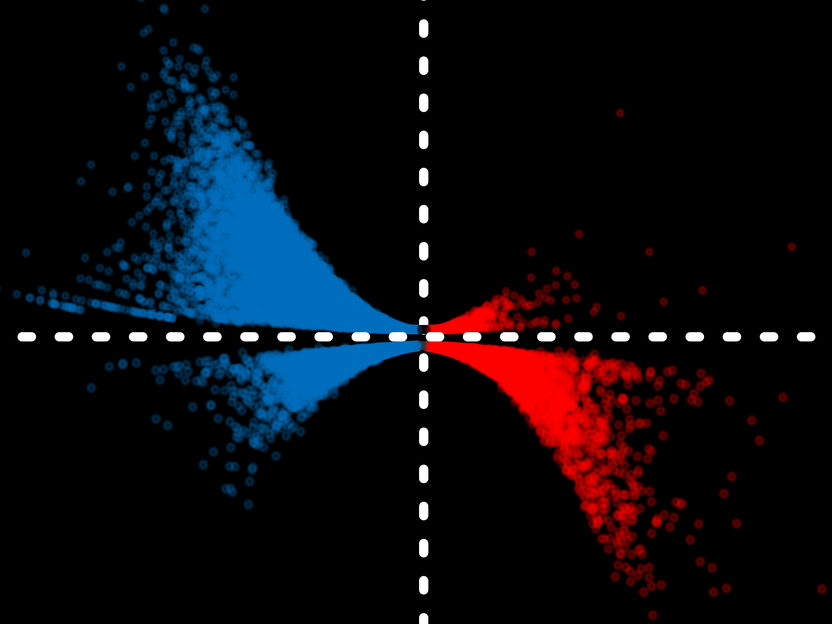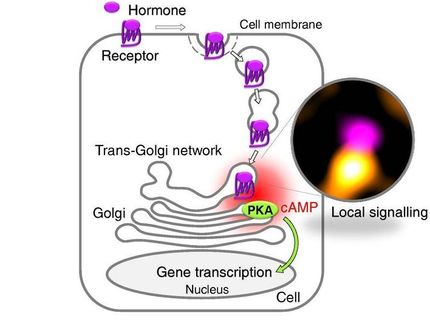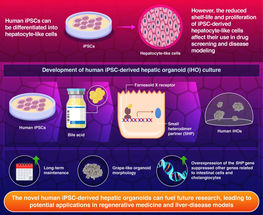An indispensable pitstop for the gene copy machine
How a protein helps making clean working copies of genes
The enzyme complex that reads genes carries other factors “piggyback” along the DNA to their destination. The protein BRD4 is essential for this process: the factors dock onto the protein during a pause from reading. The interaction also allows the cell to intervene in the process.

Artist's impression based on experimental data of a detection method for RNA polymerase molecules on gene segments. In the upper half of the image, the blue cloud of dots is predominant, symbolizing a general loss of the polymerase along genes. The lower half shows the results of an older detection method, which could not reveal these changes.
Annkatrin Bressin MPI f. molek. Genet.
It is a long way from genetic information to a recognizable trait. For genes to result in protein structures or even control the development of an entire organism, a number of events have to happen in the correct order. First of all, the cell has to read the gene from the DNA (“transcription”): it sends an enzyme complex on its way along the DNA, generating an RNA working copy of the gene. But shortly after the start, the copying enzyme already stops again.
During this pit stop, the complex that consists of RNA polymerase and several helper proteins collects other enzymes and factors. These ensure that the gene copy machine can continue its ride along the DNA so that the newly generated RNA molecule is processed correctly in the end. The protein BRD4 plays an essential role in this process. It binds the molecules involved and helps to transport them to the location along the gene where they are needed. This was discovered by a research team led by Andreas Mayer of the Max Planck Institute for Molecular Genetics (MPIMG) in Berlin and published in the journal Molecular Cell.
Observing the consequences of a precise perturbation
“Many labs around the world are currently studying BRD4 as a drug target, primarily because it is implicated in the development of various cancers including carcinomas,” Mayer says. “Our goal was to uncover the fundamental functions of BRD4 in transcription and in the downstream processing of RNA in human cells.”
To decipher the workings of BRD4, the Max Planck research group studied the protein in cultures of human cells. The scientists used a new method that allowed them to selectively remove all BRD4 molecules from the cells within just two hours, without affecting other proteins.
“We follow the principle of intervening very quickly and specifically at the protein level while measuring the immediate impact on the cell with comparable temporal resolution, well before everything gets blurred by stress responses,” Mayer says. “In other words, we throw a spanner in the works and watch directly what happens, and not only when the machine has come to a halt.”
Stuck halfway
The researchers observed how the cell reacted to the immediate loss of the BRD4 protein, and at short time intervals, sequenced the newly generated RNA molecules.
“We could see how transcription declined globally and uniformly,” says Mirjam Arnold, a doctoral student in Andreas Mayer's team and a first author of this work. The reason was that the RNA polymerase complex lingered significantly longer in the region downstream of the start of the gene and was less detectable throughout the rest of the gene. Apparently, it was stuck.
“In multicellular organisms, it is normal that the RNA polymerase starts and then pauses again after 50 to 100 nucleotides, waiting before it continues,” Arnold says. “The polymerase paused much longer than usual and seemed to be massively limited in its activity.”
Overshooting the finish line
In addition, the enzyme complex sailed well past the finish line in at least 40 percent of the detected genes and copied several thousand more DNA nucleotides from the area downstream of the actual gene. As a consequence, it generated extended RNA molecules, many of which consisted of nonsense and had the potential ability to wreak havoc in the cell.
“It was the ultimate surprise to see such a read-through effect,” says Annkatrin Bressin, also a doctoral student and first author of the study. “The enzyme complex was lacking its brakes, so to speak, and was not able to stop. Additionally, the RNA was not processed properly."
As a result, the RNA was still attached to the polymerase complex and was not cleaved and separated as it was supposed to be. Subsequent processing steps such as polyadenylation, in which enzymes add a tail of up to 250 adenine building blocks to the end of the RNA, were also impaired.
Effects at opposite ends of the gene
These phenomena caused by the rapid elimination of BRD4 puzzled the scientists. What links the observed effects at opposite ends of the same gene? A mass spectrometric search for the molecules that interact with BRD4 over time provided an explanation. The experiments were carried out in collaboration with David Meierhofer from the MPIMG, who is a specialist in such analyses.
Apparently, RNA polymerase binds BRD4 and waits for additional signals during the initial pit stop not far from the start region. These signals come in the form of elongation factors – proteins that encourage the polymerase to continue its work. If they are missing, transcription can’t proceed. BRD4 seems to help “recruit” these elongation factors and to allow productive RNA synthesis.
Notably, already at this early stage, so-called RNA processing factors contact BRD4. These are over a dozen proteins that turn the transcribed RNA molecule into its final state. They are carried piggyback by the RNA polymerase to their site of action. If these processing factors are missing, the polymerase complex generates extended RNA molecules, which may even harm the cell.
Adjusting screws for complex control systems
“BRD4 appears to be essential for the assembly of a functional enzyme complex that is able to produce RNA,” Mayer says. “This protein is clearly one of the central control knobs for the elongation phase, during which the RNA chain is assembled nucleotide by nucleotide.”
Not only the start of gene transcription, known as the initiation phase, is a way to control a gene's activity, Mayer says. The cell can also regulate the extension of the RNA transcript and the processes at the end of genes which inform the polymerase complex where to stop. If needed, it can halt or terminate at a later stage.
Having a deeper understanding of BRD4's cellular functions could also be informative for the development of therapeutic applications. “BRD4 has been observed to trigger and maintain gene regulatory circuits that are implicated in cancer development, which is why BRD4 has emerged as a therapeutic target. But the protein's exact function and mechanism of action was not clear,” the scientist says. “Now that we understand the protein's purpose better, this gain of knowledge might bring researchers a step closer to the ultimate goal of developing therapeutic strategies that intervene with higher precision, making them more effective while causing fewer side effects.”
























































